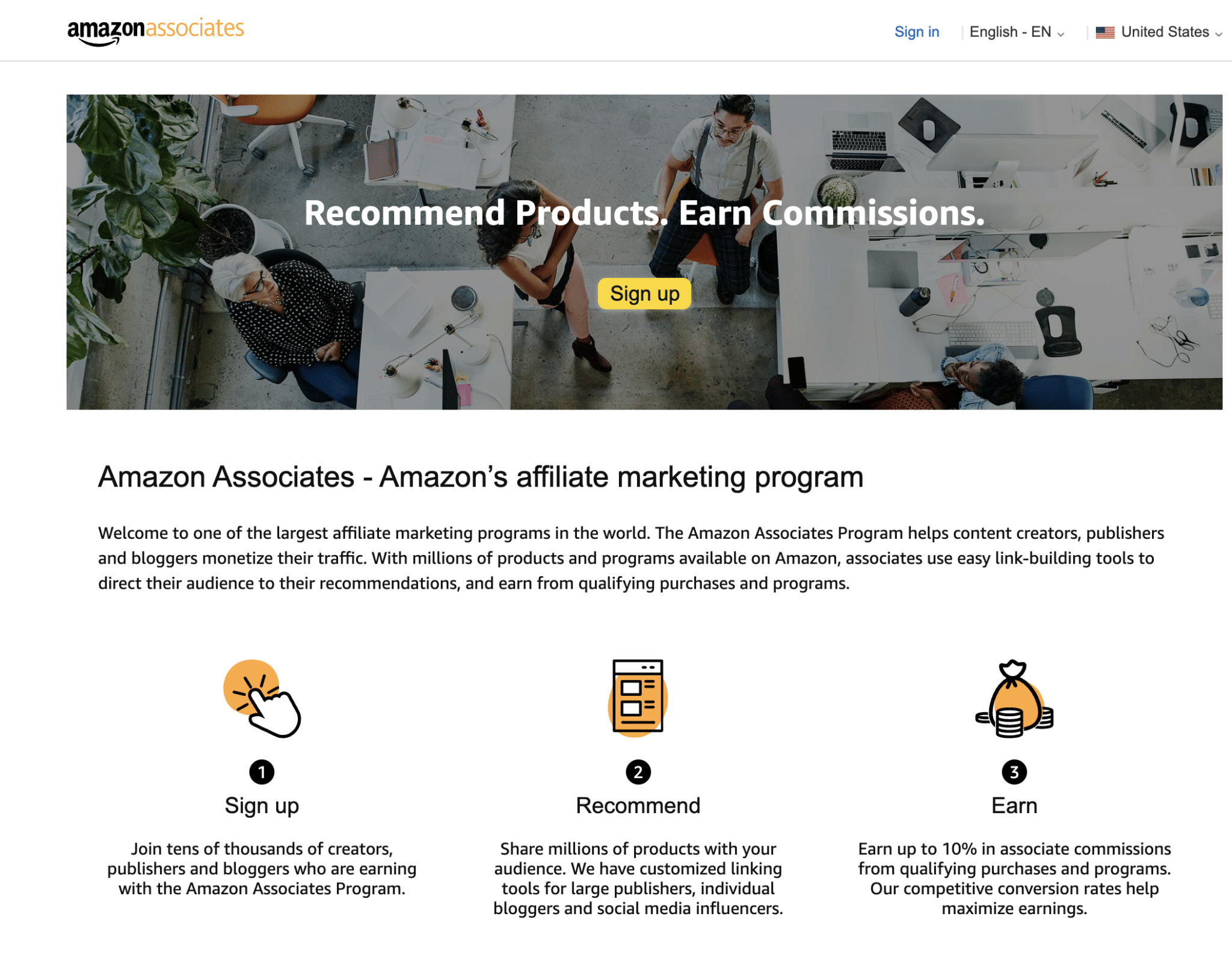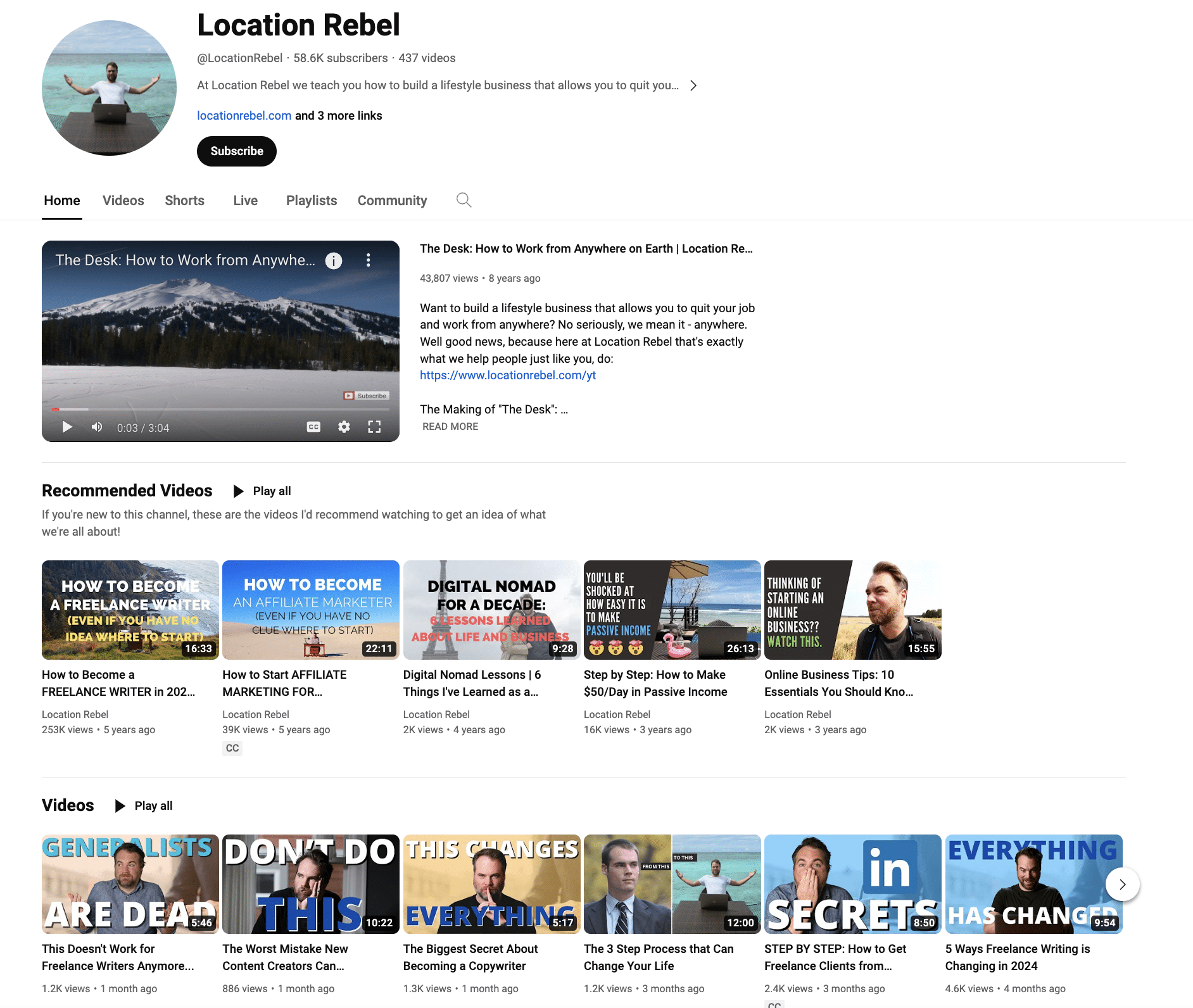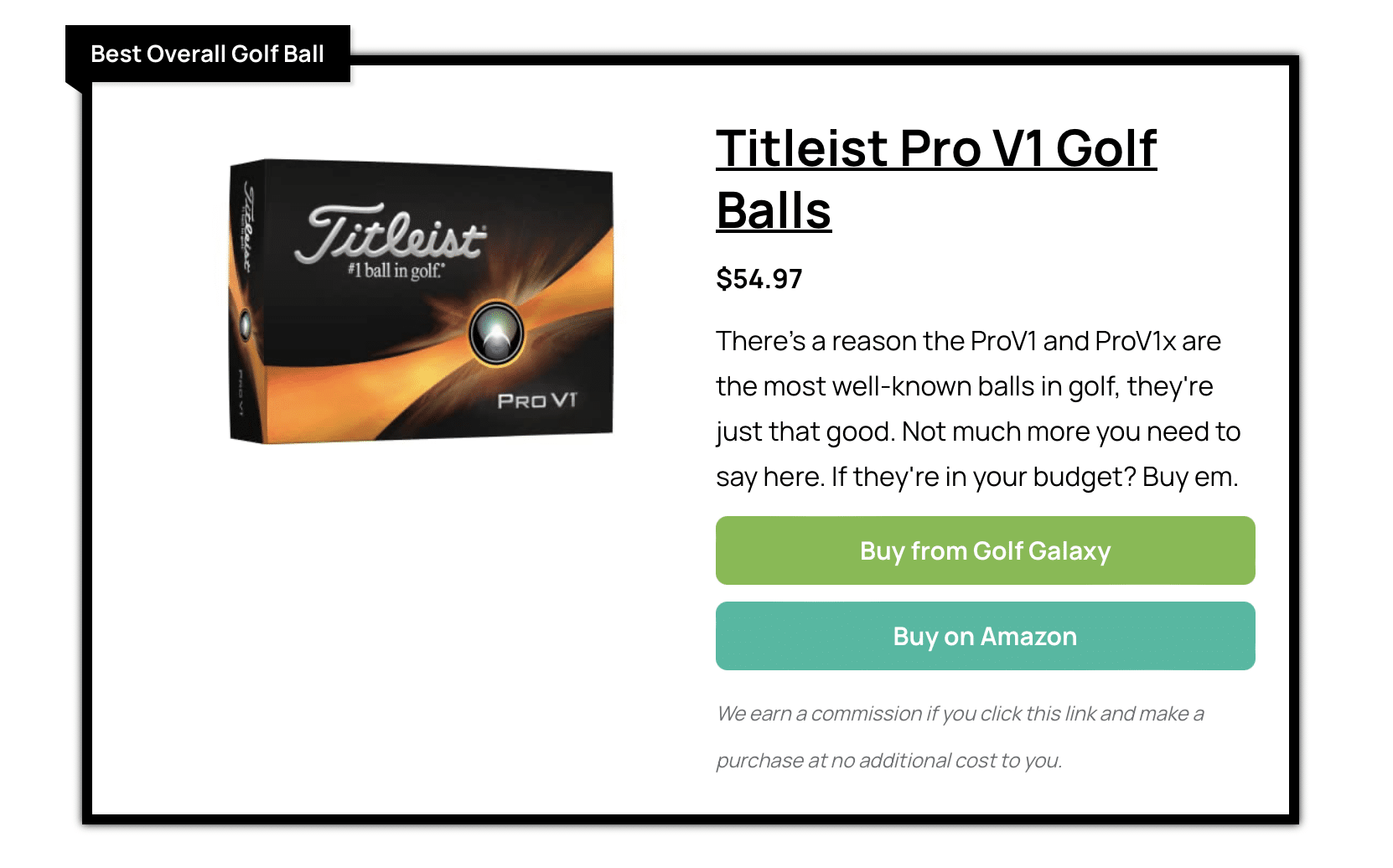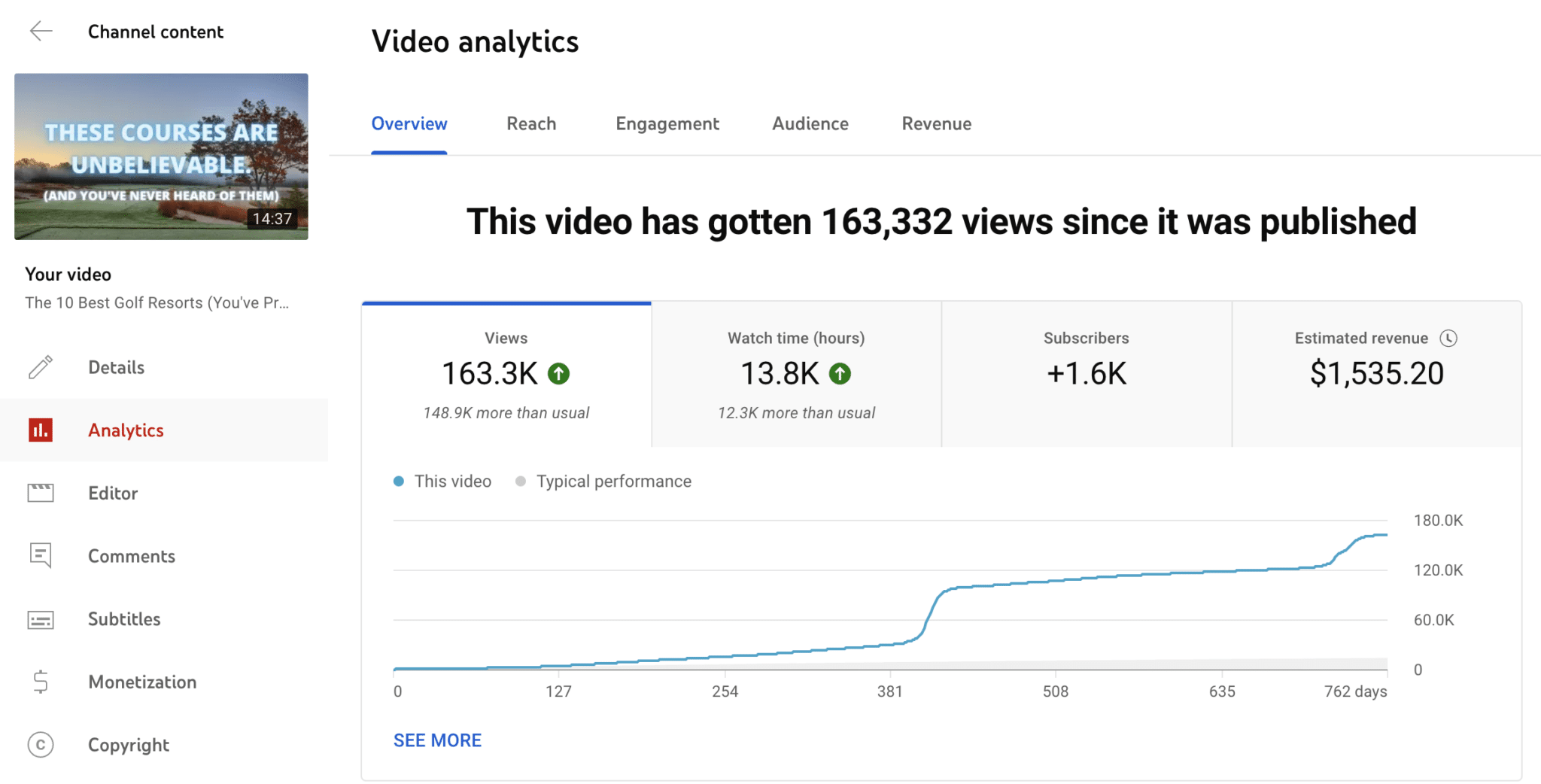How many times have you thought about (or even started) building a niche site with dreams of making thousands of dollars in passive income each month?
If you’re like most people trying to make a living on the internet, the thought has probably crossed your mind at least once, if not thousands of times.
For me, the affiliate review site concept is one of the most fascinating anomalies on the internet. It’s one of the hardest yet stupidly easy things you can do online.
And the opportunity to build a profitable affiliate site has never been better.
Take me for example. Over the last two years, I’ve made over a million dollars through my Breaking Eighty and Slightly Pretentious niche sites. All while traveling the world, playing the best golf courses, drinking the best cocktails, and reviewing the coolest golf products out there.
I’m not telling you this to brag, but to show you what’s possible.
If you’re looking to launch a business with significant financial upside, passive income potential, and the freedom to stop trading time for money (and spend more time doing what you love), then starting a niche affiliate review website and YouTube channel could be the perfect opportunity for you.
But let me be clear—the process isn’t easy. It requires a lot of hard work, dedication, and consistency.
With that said, I promise your efforts will start paying off sooner rather than later.
You’ll also have way more fun than with most other online business models. Regardless of which niche you choose, you’ll open up doors to opportunities you never thought possible.
If this sounds like the path you want to take, keep reading for a step-by-step process for building a six-figure affiliate review brand.
Let’s dive in.
Affiliate Site Video Tutorial:
Dig this video? See more lifestyle business videos on our YouTube Channel.
How to Start an Affiliate Site Quick Start
Here’s the 11-step, quick start, Cliff’s Notes version of my strategy for building a six-figure affiliate review brand.
Step 1: Choose a Niche
- Define your industry, niche, and niche within a niche to narrow down your focus.
- Check out this article on how to choose a niche.
Step #2: Research Affiliate Programs
- Search “<product name> affiliate program.”
- Visit company websites and see if they have affiliate programs.
- Check out other niche sites and see if they have affiliate links.
Step #3: Come up with 100 content ideas
- Product reviews, comparisons, how-to guides, best-of lists, list posts, and personal content all work great here.
Step #4: Get Your Website Going
Step #5: Set Up Your YouTube Channel
- Create your channel and get your handle so it’s good to go once you’re ready to start recording videos
- Read more here about leveraging blog and video in order to reach as many people as possible.
Step #6: Start Keyword Research
- Use a tool like Semrush to find 5-10 of the best key terms/products to try and rank for.
Step #7: Start Creating Content
Step #8: Create a Strict Posting Schedule
- Treat content creation like a job and stick to your schedule
Step #9: Decide on a Call To Action
- Start building an email list by offering some type of lead magnet.
Step #10: Research Future Relationships
- Start making connections and building relationships with people in your industry.
Step #11: Start publishing
- Hit publish regularly and track performance.
- Adjust your content strategy based on what resonates with your audience.
There you have it—11 steps to building an affiliate review site that will earn you six figures. Want to actually learn how to do this? Then keep reading for detailed step-by-step instructions.
Learn How to Make Your First $1,000 Freelance Writing (in 30 Days or Less)
Join over 40,000 people who have taken our 6 part freelance writing course. Sign up below and let’s do this together.
By entering your email address you agree to receive emails from Location Rebel. We’ll respect your privacy and you can unsubscribe at any time.
Crash Course: How Do You Make Money on Your Website?
Just to make sure we’re all on the same page, let’s talk real briefly about how we’re actually going to make money through this site. There are a lot of ways to make money on the internet, a few of the ones you’ll find on niche sites are:
- Affiliate Links
- Adsense Ads
- Other Paid Advertisements
- Paid Text Links
- Direct product sales
- Paid Memberships
- Newsletter Sponsorships
However, for the purposes of this post, we’re going to focus solely on affiliate marketing.
What is Affiliate Marketing?
When it comes to monetizing a niche site, affiliate links are the easiest way to get started.
What’s an affiliate link you may be wondering?
Glad you asked. Here’s the process in the simplest terms possible:
- You have a website
- Someone else has a product
- You get a special link to their product
- A reader clicks on the link and buys the product
- You get a commission
Simple as that!
However as simple as it sounds, actually getting traffic and getting people to buy products is a much more difficult task that we’ll cover in depth next.
Step #1: Choose a Niche
Before you get started building your affiliate site, it’s crucial to narrow down your focus.
How you ask? By using the Niche Within a Niche (or NWN) method.
Start by defining your industry, your niche, and then your niche within a niche.
For example, with Breaking Eighty my industry is golf, the niche is golf reviews, and one of my niches within a niche is golf rangefinder reviews.
I believe you can build a niche website around just about anything, assuming you’re passionate enough about the topic. The reason most people fail is that they choose a niche like “Swedish leather furniture” when they’re nomadic and have absolutely no interest in what they’re writing about.
Think of your new site as a blog where you’ll need to write extensively about a specific topic. If you lack knowledge or interest in the niche, you’ll likely struggle to create engaging content consistently.
To start, write out a list of every product, hobby, or interest you have that you might build a site around. This brainstorming exercise can help you find potential niches you hadn’t considered.
If you get a list of 50-100 possible niche ideas you’ll be in good shape.
To help you get started, here are a handful from my brainstorm list I did years ago:
- tennis ball machines
- Islay scotch
- Nikon cameras
- golf balls
- tripods
- golf simulators
- travel credit cards
- video editing software
- travel backpacks
- headphones
After brainstorming, narrow down your niche based on the following:
- High Price, Low Volume – I’d rather make a bunch of money off one sale than a little money off a lot of sales. This holds more true for e-commerce/dropshipping websites – but I look at it like this: if I have a low-priced product I have to get maybe 5 or 10 times as many people to actually whip out their credit cards and buy something, but if I only have to convince one person to make a good commission – it’ll be easier to make money over the long term.
- Could I write 100 articles about the topic? – My strategy is all about creating incredibly useful, shareable content – so if I can’t see myself writing 100 unique articles over the next couple of years then there’s a good chance I’m not interested in it enough to invest the time and energy into the project.
- Are there affiliate programs (with good commissions)? – There are affiliate programs out there that will allow you to sell just about anything. But the question is, what are the commissions like? The whole “high price, low volume” approach doesn’t work if you only get a 1% commission off the sale.
- Are there currently people making money? – Come up with 5-10 keywords that people might search for when looking for your product. Let’s say it’s golf launch monitors, and let’s use the Bushnell Launch Pro as our example. I might search for the following keywords: Bushnell Launch Pro review, Bushnell Launch Pro sale, and Bushnell Launch vs. FlightScope Mevo Plus. I’ll then run those through Semrush or the Google Keyword Tool to see how much traffic they each get per month.
- Are other people making money? – When I do a search for the above keywords, I’ll look for sites that continuously pop up. I’ll then visit those sites and see if they have affiliate links. If so, it’s a good indicator the site is making money from affiliate sale commissions.
There are many more scientific and in-depth ways to research this, but if you’re just starting out, this can help you get a good idea.
Check out this video for more specifics on finding a niche:
Step #2: Research Affiliate Programs
This is an often overlooked step, but researching affiliate programs is an important part of the process that will give you peace of mind knowing you can actually monetize your content.
Start by searching for the affiliate program of a specific product you have in mind. Simply Google “product name affiliate program” and see what results come up.
You can also visit company websites and check the footer for information on any affiliate programs. Some companies have dedicated pages for affiliates where you can learn more about their affiliate programs.
Another strategy is to check out existing affiliate review sites and YouTube channels in your niche and look for affiliate links in their content. If you click on a link and it redirects you to the company’s website with additional parameters in the URL like “aff-id”, it’s likely an affiliate link.
And then there’s Amazon.

Amazon has one of the largest affiliate programs globally and there are certainly people out there making a good living off nothing but Amazon affiliate sales.
And considering how easy it is to set up, it’s an excellent starting point for new affiliate sites.
But for your first site, I don’t recommend going solely the Amazon affiliate route. Amazon starts you out at 4% and as you sell more it bumps you up to around 7-8% commissions.
There’s a lot that’s attractive about it. If someone clicks a link and then buys anything you get paid.
If I had a whole site devoted to nothing but one type of item it might be different, but usually there’s going to be a more specific affiliate program for your product that will probably have higher commissions.
Here’s exactly how to start Amazon affiliate marketing to set yourself up for the best chances of success.
Step #3: Come up with 100 Content Ideas
Generating 100 content ideas might sound daunting, but it’s necessary for establishing your brand and making sure you have enough material to write about in the long term.
The last thing you want is to find out 6 months into building your affiliate site that you’ve run out of content ideas.
Keep these questions in mind as you create your list:
- Does the content have the potential to be extremely shareable? To earn natural backlinks, create content people want to share. Brush up on your headline writing and copywriting skills, as they form the basis for engaging content.
- Will the content sell? Your content should help sell products. Sharing personal stories detailing how a product has improved your life can help potential buyers connect with your brand and make the decision to buy.
- Will the content rank well? While you shouldn’t write solely for search engines, you can make it easier for them to understand your content by using relevant keywords and providing valuable, well-organized information.
Your content should cover a range of formats to keep things interesting. Here are some types of content that tend to work well:
- Product Reviews: These will be the cornerstone of your site. Create detailed product reviews within your niche that provide real value to your audience.
- Product Comparisons: Compare similar products to help your audience make informed decisions when choosing between them.
- How-To Guides: Share your niche expertise by creating in-depth guides on specific topics related to your niche.
- List Posts: People love lists. Create content that lists things like tips, ideas, or resources related to your niche. These types of posts are often super easy to read and extremely shareable.
- Best-of Lists: Compile lists of the best products or services in your niche. These lists can be based on price, features, user reviews, and the like.
- Personal Content: Share personal stories or experiences related to your niche. This content helps you connect with your audience and build your brand authority.
Step #4: Get Your Website Going
OK, now it’s time to finally get your website up and running.
Don’t stress too much about your domain name. Just make sure it’s general enough so that you can expand as your business grows.
For example, I wouldn’t go super specific with a name like golfrangefinders.com, although if that’s all you want to do, it could be a successful business.
Because I would get bored doing just that, I want the freedom and flexibility to expand out in the future. Maybe I want to talk about travel or different types of products in other industries.
In my case, using a general golf term like Breaking Eighty allows for future growth since I’m not pigeonholed into creating content I don’t want to create.
Setting up your website is relatively straightforward. Focus on getting these basics right, and you’ll be well on your way to building a successful affiliate review site:
- Buy a Domain: Use a site like Namecheap or GoDaddy.
- Get Hosting: If you expect to drive significant traffic to your site, I recommend WP Engine as a hosting provider. However if you’re starting with a smaller budget, Bluehost is more affordable and also works great.
- Install WordPress. Get a premium WordPress theme, hire someone on Fiverr to do a logo for you, and you’ll be good to go. Design is completely secondary at this point to content.
- Set Up Your Site: Once you have your domain, hosting, WordPress, and theme in place, you’re ready to start creating content.
You’ll also want to make sure you install these extra things on your site:
- Yoast SEO Plugin – Search engine traffic is going to play a big role in the success of your site. This is one of the most respected SEO plugins out there, and makes it extremely easy to see if your pages are optimized – even if you have no experience with SEO.
- Optin Monster – Building an email list will be crucial to your success – now more than ever. This is the best tool I’ve found for easily creating high converting opt in offers.
- Google XML Sitemap – You want to make it as easy as possible for the search engine spiders to find and categorize your site.
For detailed step-by-step instructions, refer to our guide on how to start a blog.
Step #5: Set Up Your YouTube Channel


Our YouTube channel for Location Rebel
Don’t stress too much about this step, especially if you’re new to being on camera.
Because let’s face it—your first videos are going to suck. But that’s okay, it’s all part of the learning process.
If you’re not ready to start filming videos yet, that’s fine. At this stage, all you need to do is create your channel and secure your handle so that it’s ready to go when you’re ready to start uploading videos.
However, don’t wait too long to dive into video content as it can be a powerful tool for building trust and authority in your niche and driving traffic to your affiliate site.
You can start creating videos with just your smartphone and a basic $50 ring light off Amazon for better lighting.
However, you should definitely consider investing in good audio equipment. People will tolerate sub-standard visuals but will click away immediately if the audio quality is lacking.
Something like the DJI microphone can really take your video quality to the next level. While it costs around $300, it’s a worthwhile investment if you’re serious about growing your YouTube channel.
Even if you’re not ready to publish videos yet, practice speaking on camera every day. Building this habit can help you improve your on-camera presence and delivery for when you start recording videos.
Step #6: Start Keyword Research
Use sites like Semrush or Ahrefs to find the best keywords and topics in your niche to target for writing your blog content. If signing up for Semrush is out of your budget, you can sign up for a free trial version.
For YouTube, I recommend using VidIQ since it’s dedicated to YouTube keyword research.
These tools give you search volume, keyword difficulty, and user intent to help you know where to focus your content creation.
Here are some other helpful ways to maximize your site’s SEO potential:
Step #7: Start Creating Content
When you’re trying to drive traffic to an affiliate blog or YouTube video you can do so in two ways:
We’re going to be doing it the legit way, which in turn makes the content on your site a thousand times more important. We’re not just writing any content either, we’re being very deliberate as it has a couple specific goals we want to accomplish:
- Extremely Sharable – Because we’re not going to be doing a lot of spammy link building, we’re going to need to get links by you know, actually creating something people want to share.
- Content that Sells – The end result of all of this is you need to get someone to buy something, so your content should help sell them on why they should do that.
- Ranks in Search Engines – You don’t want to write specifically for the algorithms, but as mentioned above, you want to make it as easy on them as possible.
So, how do we accomplish this?
Well, as mentioned above in the Quick Start, there are a few specific types of content that I’ve found work extremely well. Let’s go over them in detail.
Review Posts
One of the best ways to sell any product is to include an entire post that details how the product has had a personal effect on you. How did it improve your life? What can you do now that you couldn’t before? What were the legitimate downsides of the product?
Case Studies
If there are products that either you, or someone you know has had success with? Do a case study! These are not only encouraging to people, but they can also be a great way of selling a product without having to actually do much selling.
Here’s an example of a case study I did on my experience with Interact Quiz Builder.
Detailed Tutorials Showcasing a Product
Just as important as review posts are posts where people can learn a thing or two – after all your readers won’t always be in a buying mode, so you want to get them to come back on a fairly regular basis and build loyalty to your brand.
List Posts About Your Niche
List posts are easy to read and easy to share. People love them, even if they often don’t provide as much in-depth value as the previous two kinds of posts.
If there are a lot of products in your niche, you can potentially make these posts profitable by writing articles with titles like:
- 5 Best Point and Shoot Cameras for Low Light
- 3 Best Golf Shoes for Playing in the Rain
- 7 A/V Receivers That Will Make Your Neighbors Hate You
The Magic Words: “Best” and “Year”

There are two key terms that have absolutely drive more traffic to my niche and authority sites more than anything else.
The first is “best.”
I alluded to this above in the part about list posts.
Think about how you search. When you’re looking for recommendations or are considering buying something, I’d be willing to guess you have used the word best in dozens of searches.
Some examples:
You get the idea. They are generally high-traffic terms that indicate buying intention and are generally pretty easy to write.
You can modify this even more by adding the current year.
- best travel gifts for 2024
- best business books 2024
- etc.
Here’s a good outline to get you going:
- Write 5 articles reviewing 5 of the most popular items in your niche
- Write 3 in-depth tutorials on your niche (How to _______)
- Write 3 list posts
- Repeat
Step #8: Create a Strict Posting Schedule
Think of this step as creating a blueprint for your publishing routine.
If you’re serious about building a six-figure affiliate site, you have to approach content creation with the same level of dedication as you would a job.
First, determine how often and on which days you’ll publish new content. Whether it’s every Monday, Wednesday, and Friday, once a week, or twice per month, choose a posting schedule that you can maintain long term.
Consistency is key here. Once you’ve decided on your posting schedule, make it public knowledge. Share it on your website, socials, or through your email list.
This transparency informs your audience about when to expect new content while adding trust and credibility to your brand.
Step #9: Decide on a Call To Action
Your call to action (or CTA) is something you might overlook, but it’s one of the most important things you can do within your content.
Giving people an actionable step at the end of your content helps simplify the decision-making progress and makes it easier for your audience to take that next step that earns you money.
For example, if it’s a product review, your CTA may be as simple as “Click this link” or “Buy this product.”
Here’s an example of one of my call-to-action boxes on Breaking Eighty:
I use the tool Lasso to build these, which is excellent for making clear CTAs and highlighting product reviews.
However, you should have a more overarching CTA across your entire business that allows you to start building an asset.
In my opinion, the best asset to start building is an email list.
When it comes to the algorithms on Google and social media, you’re at their mercy. But when you have an email list, it’s something you own that can’t be taken away from you.
Your email list consists of people you can still reach out to if all else fails. Plus, every time you publish new content, you can email your list to get some eyeballs on it.
I recommend you start building an email list ASAP.
The best way to do this is to create an offer compelling enough to get someone to give you their email address.
While some people will like your content enough to sign up for your newsletter so they can hear more from you, most people need a little more convincing.
Here’s where lead magnets come into play. Essentially, you give people something useful in exchange for their email addresses.
On Location Rebel, I have a free 6-day email course that takes you through how to build a sustainable freelance writing business. When people sign up, they receive the first lesson immediately and it walks them through 6 days of valuable and actionable content.
Another lead magnet that’s worked really well for me is quizzes on Breaking Eighty.
For example, if someone reads a post on the best golf launch monitors and can’t decide which one is right for them, I offer a 30-second quiz where I make my best recommendations based on their specific needs. At the end, they have to put in their email address to get the results.
If all goes well, they’re going to buy that product and I’m going to get a commission off the sale.
It’s a win-win. They get a product they’re really happy with, and I earn money and satisfaction from helping someone make that decision.
Step #10: Research Future Relationships
One of the best ways to grow your niche site is to get active within your industry and start making connections with people.
Here are some people to reach out to in your industry:
- People running other affiliate review sites
- Social media influencers or managers
- Business owners
These relationships can open doors to collaborations, guest posting opportunities, and more.
Remember—everyone you interact with online is a real person, so the more relationships you can build within your industry, the better your chances of having success.
With Breaking Eighty I built a relationship with the person in charge of social media at Golf Digest. They shared some of my Instagram photos, which led to hundreds of new followers and website visitors who then joined my email list and became regular readers.


Here’s one of my photos that Golf Digest shared back in the day.
What’s the lesson here?
Take the time to figure out who are the people you want to get to know in your industry. Once you’ve established who they are, figure out how you can help them so you can build relationships and grow quicker in the process.
Step #11: Start Publishing
Now that you’ve laid the groundwork for your affiliate review site, it’s time to start publishing content regularly.
Track the performance of your posts and adjust your content strategy based on what resonates with your audience.
What content seems to get people excited and engaged? Do more of that.
What content gets crickets? Do less of it.
Building traction takes time, so be patient and keep creating valuable content.
So don’t get discouraged if your content doesn’t take off immediately. Chances are nothing you create in the beginning will.
And don’t fall victim to imposter syndrome – you’ve got this.
This is also another example of how video content can be so valuable. You can have a YouTube video that gets no engagement for months, then suddenly 6 months or a year later it blows up.
This video I did about unique golf resorts didn’t do much until over a year after it came out. Then it started getting 1,000 views a day for a couple months.
A year after that? It did it again. So you never know what’s going to hit.

As you become an expert in your niche, algorithms will start working in your favor, driving more traffic to your site and helping you grow your business.
Consistently publishing new content requires a lot of work upfront, but if you follow this process, you will have the potential for a six figure business that will change your life.
FAQs
How do you get products to review?
Start with items you already own and like. These are the products you’re likely the most excited and knowledgeable about.
You can also buy products online to review and return them afterward, but I suggest not making a habit of it.
Once you’ve published a lot of content and built a solid reputation around your brand, contact companies you’re interested in working with to see if they would be willing to send you products for review.
How much can you expect to make with an affiliate commission?
Affiliate commissions can range widely from 3% to 70% or more, depending on the retailer and product.
Amazon typically offers around 3% commission, while smaller companies selling a handful of products only might offer 10% or more.
Information products usually offer higher commissions ranging from 20% to 50%.
What type of products should you review?
Again my recommendation is to focus on high-priced, low-volume products in industries where people are eager to spend money.
For example, selling a $3,000 golf launch monitor with a $300 commission has a higher money-making potential than selling a hundred $30 t-shirts with a $3 commission.
At the end of the day, choose an industry that aligns with your interests and where people are excited to spend money. Here are some examples:
- Golf
- Travel
- Photography
- Outdoor gear
- Home automation
Want to Go Even More In-Depth?
Feel free to comment below if you have any questions. I’ve been in this industry for over a decade and would love to help you out.
This article tells you all you need to know in order to get started. But I’ve built an entire blueprint on affiliate marketing and niche sites insideLocation Rebel Academy that will totally hold your hand if you want more help.
For this, and so, so much more, check out my private community and business building course Location Rebel Academy.
Sean Ogle
Sean Ogle is the Founder of Location Rebel where he has spent the last 12+ years teaching people how to build online businesses that give them the freedom to do more of the things they like to do in life. When he’s not in the coffee shops of Portland, or the beaches of Bali, he’s probably sneaking into some other high-class establishment where he most certainly doesn’t belong.
Learn How to Make Your First $1,000 Freelance Writing (in 30 Days or Less)
Join over 40,000 people who have taken our 6 part freelance writing course. Sign up below and let’s do this together.
By entering your email address you agree to receive emails from Location Rebel. We’ll respect your privacy and you can unsubscribe at any time.



